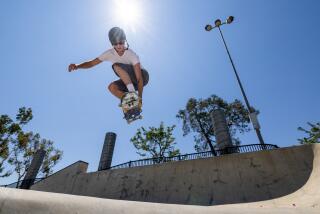Platform Shoes and Scooterboards Gain a Foothold in Japan
- Share via
TOKYO — They whiz down congested sidewalks, turning a mundane walk into an urban romp. They collapse and cuddle under an arm in the crowded subway. They can jump, slalom or merely stroll. They turn heads, induce giggles and, in this shy nation, supply a pretext for conversation.
A fusion of scooter and skateboard, these scooterboards have become the hottest form of transportation in Tokyo. So hot, in fact, that most Japanese probably won’t be able to buy one until later this spring, when supply is expected to catch up with demand. Fads here tend to be recession-proof.
“We have orders from about 50 or 60 customers. Some ordered theirs at the end of the year, and they’re still waiting,” said Kenji Adachi, 30, manager of the Outdoor Fuma sports store. He sometimes uses his three-wheeled Kickboard to zip to work through the dense concrete maze of Tokyo’s Shinjuku neighborhood. “We probably could sell 200 or 300 of them by summer, but we don’t have any to sell.”
The scooterboard craze has intersected another fashion frenzy: platform shoes, the steeper and more outlandish the better. For nearly two years now, young Japanese women have been teetering across town on 4-, 6- or even 8-inch stilts.
It was platform sandals last summer, platform boots this winter. They could be outre again by summer, judging by an industry survey that found 40% of women in their 20s and 25% of women in their 30s already own at least one pair. That’s a fail-safe Japanese indicator that it’s time to move on.
Lately the skyscraper shoes are part of an outrageous look that includes bleached blond hair, deeply tanned skin covered with a thick layer of pancake makeup, glow-in-the-dark eye shadow and whitish lipstick. Detractors call such young women yamamba, after the filthy and frightening mountain women of Japanese folklore who kidnap and eat children.
Most of the twentysomethings lucky enough to have snagged scooterboards are male and clad in sneakers and snowboarder-inspired street fashion. Devotees can be seen practicing “carving” (squatting into a turn) or jumping obstacles in downtown parks. But boarders have also been sighted wearing suits, eating ice cream, trotting dogs on leashes and, yes, gliding along atop platform shoes.
“It’s no problem once you get used to it,” said an 18-year-old who perched like a flamingo atop steep shoes while gliding through the fashion hub of Harajuku.
The Japanese police aren’t so sure. A scooterboarder having dangerous amounts of fun was recently accused of mowing down one pedestrian, who suffered minor injuries.
More menacing are the platform shoes, which have been blamed for two fatal car accidents caused by young women whose outsize footwear kept them from reaching the brakes. The Osaka police recently sent eight female officers out to test-drive an obstacle course wearing 4 1/2-inch soles and let the media document the predictable results. At least two prefectures are expanding regulations that prohibit driving in traditional geta, the high wooden sandals, to include platform shoes. Violators could be fined as much as $65.
A National Police Agency spokesman solemnly declined comment on media reports that scooterboard regulations are under consideration.
The boards may be too hot to halt. The three-wheel Kickboard retails for about $330, and 6,000 have been sold in Japan since they hit the market last April, said John Hopkins of K2 Japan Corp., which imports them from Taiwan. The company has a backlog of 20,000 orders and thinks that it could sell as many as 50,000 boards this year--once it gets enough of them.
Meanwhile, the Kickboards are going for as much as $500 on the Internet.
A two-wheeled board called the Razor, which comes from the same factory and costs about $145 here, is a bit easier to come by and almost as cool but harder to maneuver. Several popular stores have received shipments of Razor boards in the last two weeks but have sold out within two to three days.
The Kickboards--which are also hot in Germany, according to K2--are eco-friendly, have good brakes, can be adjusted for the weight of the rider and can easily be picked up to avoid collisions.
Most important to crowded Tokyo, they need not compete with bicycles for nonexistent parking space on minimalist sidewalks outside supermarkets and stations.
The only question is whether they can outlast platform shoes.
More to Read
Sign up for Essential California
The most important California stories and recommendations in your inbox every morning.
You may occasionally receive promotional content from the Los Angeles Times.










